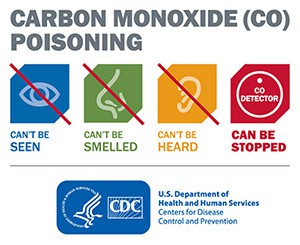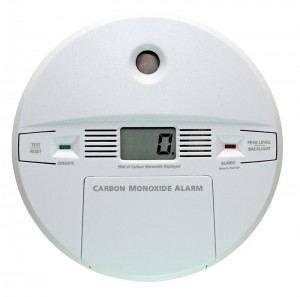Carbon Monoxide Poisoning Prevention
Posted on by Daylight Savings Time ends Sunday, November 4. As you prepare to set your clocks back one hour, remember to check the batteries in your carbon monoxide (CO) detector. If you don’t have a battery-powered or battery back-up CO alarm, now is a great time to buy one. More than 400 people die each year in the United States from unintentional, non-fire related CO poisoning.
Daylight Savings Time ends Sunday, November 4. As you prepare to set your clocks back one hour, remember to check the batteries in your carbon monoxide (CO) detector. If you don’t have a battery-powered or battery back-up CO alarm, now is a great time to buy one. More than 400 people die each year in the United States from unintentional, non-fire related CO poisoning.
CO is found in fumes produced by furnaces, vehicles, generators, stoves, lanterns, gas ranges, or burning charcoal or wood. CO from these sources can build up in enclosed or partially enclosed spaces. People and animals in these spaces can be poisoned and can die from breathing CO.
When power outages occur during emergencies such as hurricanes or severe storms, the use of alternative sources of power for heating, cooling, or cooking can cause CO to build up in a home, garage, or camper and to poison the people and animals inside.

You Can Prevent Carbon Monoxide Exposure
Do
- Have your heating system, water heater and any other gas, oil, or coal burning appliances serviced by a qualified technician every year.
- Install a battery-operated or battery back-up CO detector in your home and check or replace the battery when you change the time on your clocks each spring and fall.
- Leave your home immediately and call 911 if your CO detector ever sounds. Seek prompt medical attention if you suspect CO poisoning and are feeling dizzy, light-headed, or nauseated.
Don’t
- Run a car or truck inside a garage attached to your house, even if you leave the door open.
- Burn anything in a stove or fireplace that isn’t vented.
- Heat your house with a gas oven.
- Use a generator, charcoal grill, camp stove, or other gasoline or charcoal-burning device inside your home, basement, or garage or outside less than 20 feet from a window, door, or vent.
CO poisoning is entirely preventable. You can protect yourself and your family by acting wisely in case of a power outage and learning the symptoms of CO poisoning.
Click here for important CO poisoning prevention tips in 16 additional languages.
For more information, please visit www.cdc.gov/co.
Tweet this: “CDC says Carbon Monoxide Poisoning is Preventable. Learn how. Visit https://bit.ly/2POlxu6 for quick do’s and don’ts.”
One comment on “Carbon Monoxide Poisoning Prevention”
Comments listed below are posted by individuals not associated with CDC, unless otherwise stated. These comments do not represent the official views of CDC, and CDC does not guarantee that any information posted by individuals on this site is correct, and disclaims any liability for any loss or damage resulting from reliance on any such information. Read more about our comment policy ».
Great reminder for everyone, especially mechanics who are at higher risk of CO exposure. Too many mechanics have suffered untimely deaths because they didn’t follow these simple rules: https://carcarehumbletexas.com/auto-repair-101-preventing-carbon-monoxide-exposure/ Carbon monoxide poisoning is preventable, but people have to be informed and take measures to protect themselves and others. Thanks for this life-saving information. Now if I could just get used to the new daylight savings schedule!